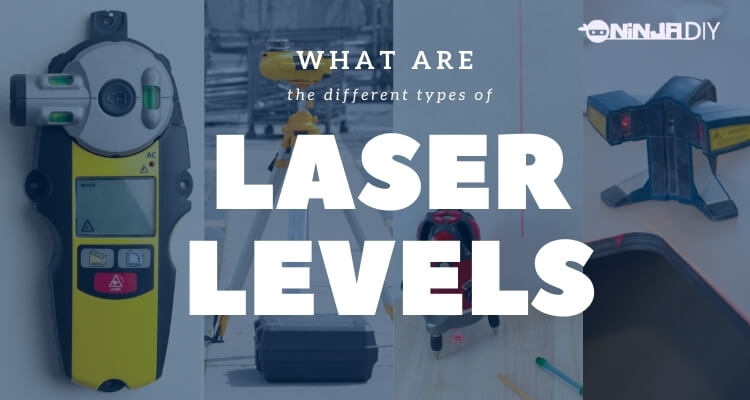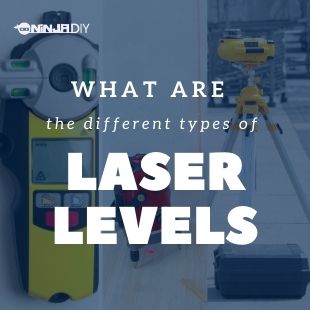If you’ve ever had the chance to work on a construction site, you might as well have come across a laser level. But you might wonder how many different types of laser levels are out there? Are there any differences between them? Can you use one for all the jobs?

Our aim with this article is to help you differentiate between all the commonly used laser levels, all while helping you figure out the right places for their use!
A laser level is a rather commonly employed control tool that makes use of a focused and amplified laser beam that helps you align literally anything – ranging from shelves and cabinets to floors and ceilings.
There will be one for your specific needs too, so let’s get straight into it…
How many types of laser levels are available on the market?
There is a huge variety of laser levels available in the market today, with all of them designed to suit very specific needs.
To give you a better insight on 4 of the different laser level types, we have compiled this guide for you!
Here’s the first and the most simple one…
1. Line Laser Levels
What is a line laser level?
A line laser level, as the name itself suggests, displays an accurately horizontal or vertical laser beam.
How does a line laser level work?
An electronic component known as a diode creates a beam of light. This light is produced and projected at 180 or 360 degrees when the current passes through the diode, as it is a semiconductor.
Where can a line laser level be used?
The purpose of a line laser level is to give us either an accurately horizontal plane or a vertical plane. This implies that it’s good for anything that needs vertical or horizontal leveling around a room, or in a room, hence indoors.
A few possible uses would include:
- Installing cabinets and shelves
- Installing chair rails, etc.
- Basic leveling of drop ceilings and floors
- Aligning walls
- Framing outdoor decks
Examples
2. Spot/Dot Laser Levels
What is a spot/dot laser level?
Instead of a beam of light, a spot/dot laser level only emits a dot laser.
How does a spot/dot laser level work?
Some of the spot/dot laser levels emit 2,3 or 5 of these dot lasers at 90 degrees. But usually, they have a plumb up, plumb down, and a dot or spot at 90 degrees.
Where can a spot/dot laser level be used?
The spot/dot laser is also typically more suited towards indoor uses involving accuracy in:
- Electric light placement
- Cabinet set layouts
- Building a level wall
- Establishing the height of a deck floor
- Transferring a single point from the floor to the ceiling
Examples
3. Cross Line Laser Levels
What is a cross line laser level?
A cross line laser level is very similar to a line laser level in the sense that it also displays a straight and accurately horizontal or vertical line but through a prism.
How does a cross line laser level work?
In a cross line laser, the beam of light is projected onto a plane that needs vertical or horizontal accuracy, but instead of being directly projected, a prism is utilized for the purpose. So, the prism basically works to deflect the laser through 180 degrees.
Where can a cross line laser level be used?
The uses of a cross line laser level are also similar to those of a line laser level, making it typically good for indoors. A few uses include:
- Projecting any given plumb line, such as for walls
- Checking door and window heights
- Installing drop ceilings
- Leveling floors
- Aligning shelves, cabinets, etc.
Examples
- Cross Line Laser Level by Bosch
- Huepar cross line laser
- Self Leveling Cross Line Laser Level by Dewalt
4. Rotary Laser Levels
What is a rotary laser level?
A rotary laser level is capable of giving not only perfectly vertical lines but also slopes to suit your needs.
How does a rotary laser level work?
With a single point diode giving out the light, a rotary laser level ensures that you get a sharp laser pointed where intended, without wasting the range into spreading out the light on a nearby point.
However, since the laser level rotates, it only stays at a particular point for a rather short period of time.
Still, the laser can be restricted to any given angle.
Where can a rotary laser level be used?
Given its wide range, a rotary laser level has been designed for outdoor usage. Whether you’re looking to excavate an area or build sharply accurate concrete forms, this laser level is your only choice.
This, however, doesn’t mean that a rotary laser level can’t be used indoors.
A few good uses include:
- Excavating
- Digging an area down or building it up
- Masonry alignment
- Site layouts
- Checking land elevations
- Aligning and leveling fences, posts, decks, etc.
Examples
- Self Leveling Rotary Laser Level by TOPCON
- Rotary Laser Level by Leica Rugby
- Rotary Laser Level by Spectra
The 2 Different Types of Laser Beams in Laser Levels
Red Beam Vs. Green Beam
There are only two colored beams of light used in all the different laser levels. As far as the accuracy of the two is concerned, there is no difference between the two beams of lasers employed.
The difference is seen in factors such as the visibility to the human eye, the range of distance covered, etc.
In that comparison, the green beam seems to produce a sharper point as it has more visibility to the human eye. Therefore, laser levels with a green beam also tend to be more expensive than the ones with a regular red beam. Here’s a more in-depth page comparing a red laser level beam to a green laser level beam.
Types of laser levels based on their leveling system
Manual Leveling Vs. Auto-Leveling
As the names very well themselves suggest, the only difference between a manually leveling and an automatically leveling laser level would be the prior tool’s requirement to be operated manually.
In a manual leveling laser level, one has to set the laser beam accurately on the point that is intended to be focused at. On the other hand, an auto-leveling laser level will automatically point at a given position considering the range that it is provided with.
What hazards are associated with the use of these laser levels? (If Any)
Laser beams are generally known to be dangerous to humans in the sense that they emit radiation in the form of light.
This implies that under extreme or prolonged and careless exposure to the beam of a laser level, a person may develop conditions ranging from as mild as a skin rash to as harsh and irreversible as a permanent eye injury.
For these reasons, it is always important to make sure that you wear safety lenses when making use of lasers, and not try to repair any such device without professional help.
How to choose the right laser level for your task?
With the range available in the market today, it’s a tough call to choose a laser level that would accurately fit the description of your needs. But for starters, you need to be sure of what your own requirements are before you set out to buy one for yourself.
Generally, a person should be aware of the maximum uses that they could make out of one laser level. With that requirement in mind, it is best to check the range of any given laser level by looking up its diameter and radius.
This helps determine how far its beam will go, helping you figure out if it’s suitable for your specific work type or not.
Bottom Line: Should You Get Yourself a Laser Level?
Of course! This is a no-brainer. Every DIYer and construction pro should have a laser level! If you’re still not convinced, check out the are laser levels a good investment page.
With the accuracy and sharpness that a laser level is ready to offer you, it’s a rather safe investment to make.
In fact, with the range of works that you can do with the help of just one type of laser level, it’s also fair to say that you will be needing your purchased laser level for more than just the intended task, making it even more worthwhile!
Ninja Team Members Working On This Page

Adrian Bull – Construction Professional
Construction Professional, driver, crane operator, handyman … As a construction pro I love to get creative and see things done with my hands coming to life. Here I share with you some of the things I learn and hopefully you’ll get something out of it. Enjoy 🙂














